October Macro Matters
MACRO PHOTOGRAPHERS DIARY (October 2021)
Title: NATURES PATTERNS ON STONE AND WOOD (Lichens)

Pectenia plumbea
A widespread foliose species found on the trunks and branches of trees in mainly intact woodlands. It is occasionally seen on coastal rocks.
.As we head into October temperatures gradually drop and summer insects and flowers reach the end of the cycle. The autumn brings colour to the leaves before they fall and there is less about to focus one’s attention on. However, unlike some other photographic disciplines, which may be seasonal, macro photography is not. Of course, the choice of subject material changes as the season’s progress, but this is what I enjoy about the miniature world, the diversity that nature has to offer throughout the year. There is still plenty of subject material for the macro photographer to explore albeit at a more relaxed pace. Natural cycles are good and it gives one time to reflect and catch up on editing and other things that require attention.
Autumn and winter is a great time to explore the fascinating world of lichens. These amazing organisms are often overlooked and underrated by photographers, but they are important monitors of the health and wellbeing of our environment. Many are colourful but demand careful attention if you are to get the best from them. They also help to sharpen up one’s compositional skills and are excellent subjects to test your technical ability on.
As autumn rolls in and the nights get longer. Many photographers at this time of the year enter what I call “seasonal dormancy” or “diapause”; emerging again in spring when the nights are brighter and the weather warmer. The downside to this of course is the fact that you lose a certain degree of familiarity with the workings of your equipment. Any progress that you may have made in terms of fieldcraft or refining your techniques is, in some ways, compromised due to inactivity and lack of practice. After all, you would not expect a professional footballer to play 90 minute’s on the field if he had spent the last few months lying about. This is equally true in photography; it is important to keep up your interest during the less productive months; it keeps you in touch with your equipment, techniques and fieldcraft skills. Remember the camera is the last link in the photographic process; knowledge and fieldcraft are the tools that create the opportunity.
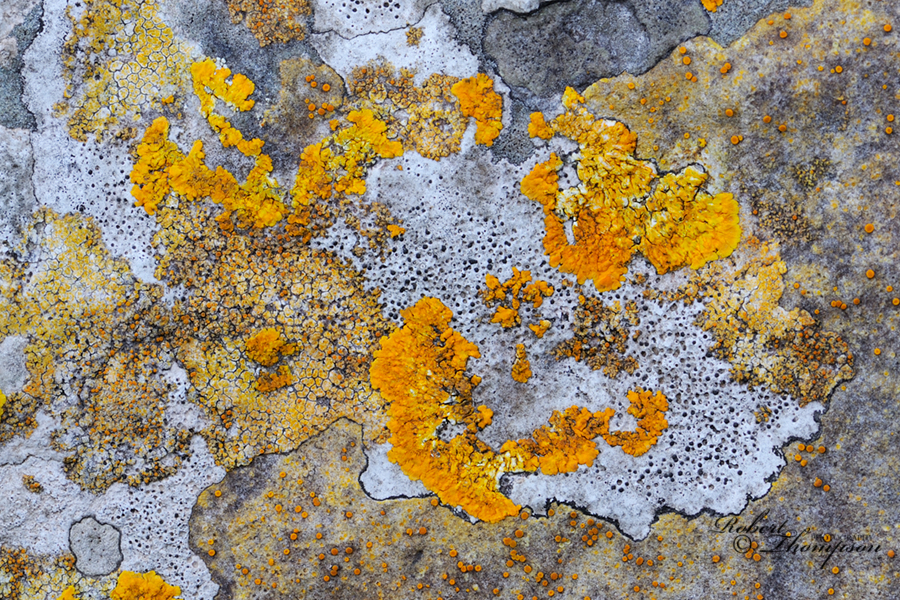
Caloplaca ochracea
An attractive species that favours natural limestone areas. It often forms patterns on the rock, sometimes in association with other Caloplaca species. It is widely distributed throughout the British Isles, but more commonly encountered in the southwest of Ireland and southern counties of England.
Lichens are at their best during the autumn and winter months when the trees are devoid of leaves and the moisture level in the air is higher. Many species have a real colourful vibrancy to them at this time of the year, particularly after rain. These remarkable organisms are the result of a successful partnership between a fungus, an alga, or a cyanobacterium, or both, existing together in a symbiotic relationship. The fungus provides the structure or the thallus as it is known and the alga, or cyanobacterium through photosynthesis provides the essential nutrients. This is a highly successful partnership that stems back millions of years. Many lichens are also sensitive to pollution and are important biomonitors, of the health of our environment. They grow in some of the most unlikely places and manage to survive in the most inhospitable places on the planet.
The larger eye-catching species form patchworks of colour on rocks and decorate the trunks and branches of trees and gravestones. They also have many other applications and are used in medicines, perfumes and as dyes to colour wool and other fabrics. They are also an important food source for snails and slugs and many insects including the larvae of some moths. There are over 1700 species of lichen described in the British Isles and probably many more awaiting identification and discovery.
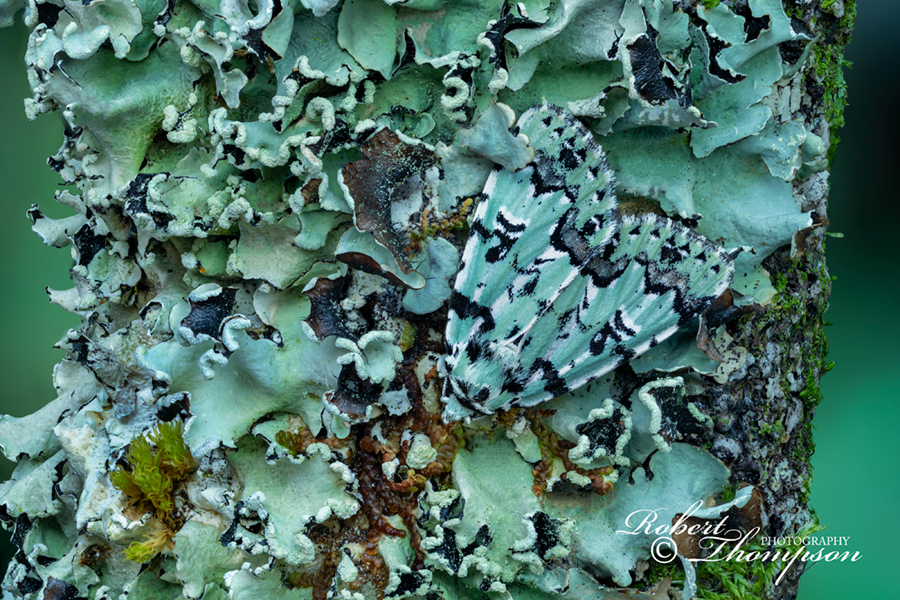
Scarce Merveille du Jour Moma alpium
A beautiful moth that is classified as a Red Data Species in Britain. The mosaic forewings blend nicely when at rest among lichens on a branch or the trunk of a tree making the moth difficult to detect.
WHERE TO FIND LICHENS
Most people are more aware of lichens in a coastal environment. The vibrant orange and yellow colours of the Caloplaca’s and Xanthoria’s are some of the most common species seen on coastal rocks. This is a good place to begin your explorations. Old native woodlands also contain a large number of species, but a little more diligent searching of the trunks and branches of trees are required to find some of the most interesting species. Some lichens form patterns and mosaics on certain trees such as Holly and Hazel and these should be examined, especially the older specimens. Heaths and bogs are good for Cladonia species, which resemble redheaded matches and deer’s antlers. Old churchyards are also excellent habitats for crustose species – these are lichens that spread and embed themselves into the rocks and cannot be removed from the surface. Many thrive on the various types of gravestones and monuments forming patterns. The most productive are those, which are well weathered and have been neglected for many years. If you plan a photographic trip to a churchyard choose a day with no rain as many of the species that inhabit rocks are better photographed in dry conditions. This also applies to upland mountainous areas as well.
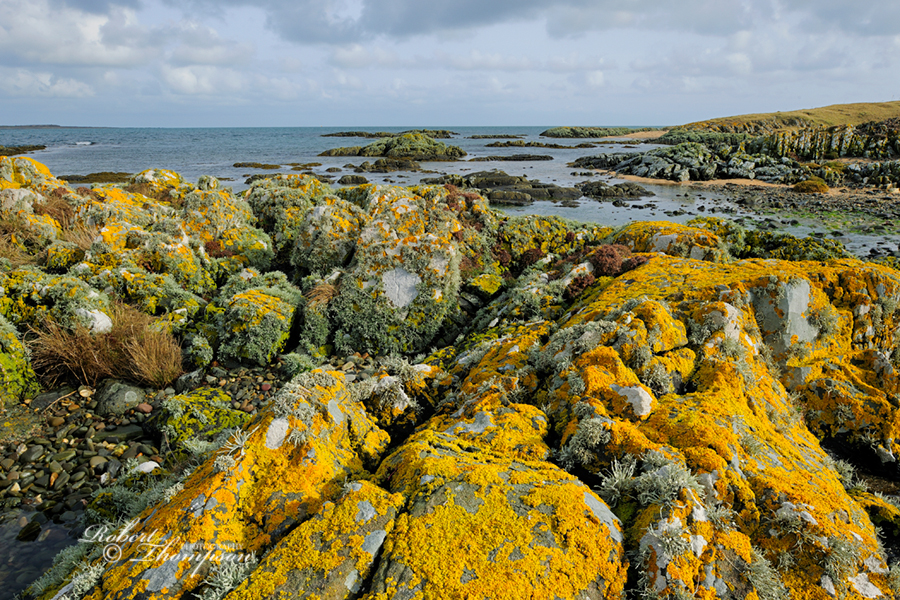
Xanthoria aureola Ramalina siliquosa & associated species
The vibrant yellow patches of Xanthoria aureola add colour to the rocks in coastal localities. This group are among the most colourful species found thoughout Britain and Ireland.

Usnea species
What attracted me to this composition was the Usnea entangled around the branch and the single cone. Photographed with a long lens to keep the background well diffused.
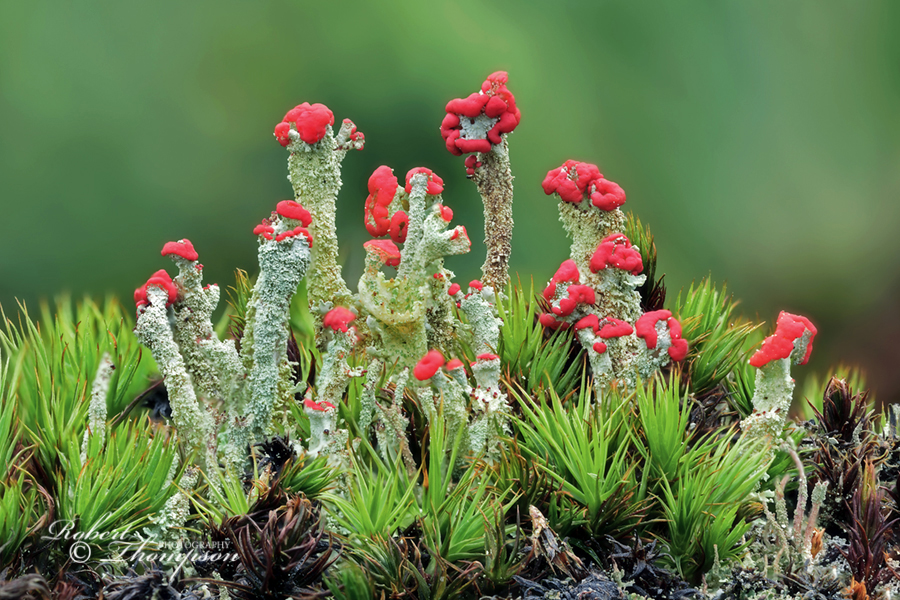
Cladonia diversa
One of the most striking and commonly photographed lichens in the Cladonia group. Many cladonias are found in moorland and bogland habitats.

Lochrolechia parella Pertusaria pertusa Porpidia crustulata & Fuscidea cyathoides var. cyathoides
Graveyards are among the most interesting habitats for lichens. The most productive ones are those which are old and neglected. Whole lichen communities can be found on a single ancient gravestone.
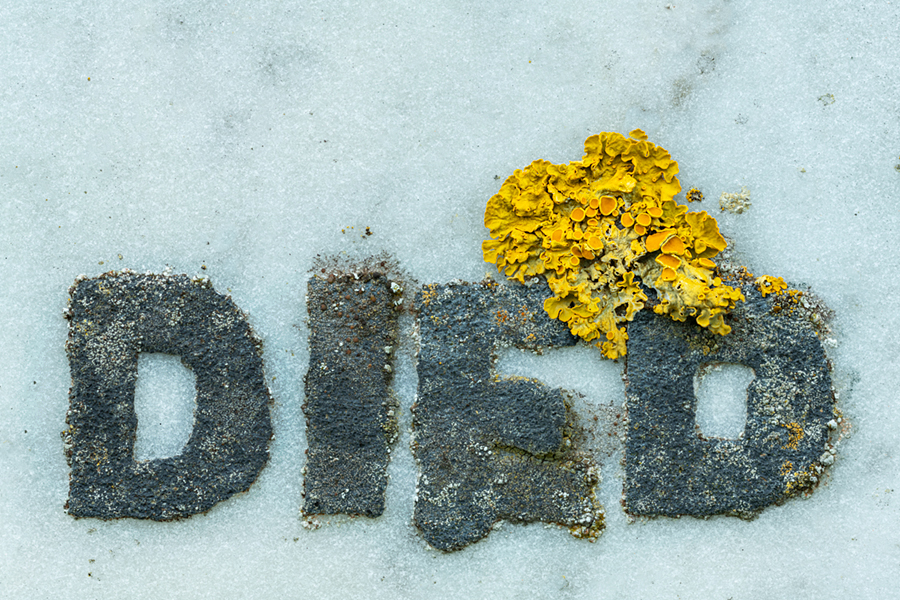
Xanthoria parientina
A small Xanthoria occupies an interesting spot on this very old gravestone; it was the only species colonising it.
It has often been said that static subjects present no great photographic challenge; this is simply untrue and often it is these subjects that require much more thought and attention to get the best from them. Photographic technique is especially important with lichens. Their intricate detail can be compromised especially when enlarging the image. I have proven this time and again. Photographic technique and solid support are essential in my opinion if you want to produce consistent results. Vibration can be a problem at higher magnifications, even when using a focusing rail. Making sure the tripod is absolutely secure is a critical factor as the terrain is not always that solid. I shoot the majority of lichens using natural light and always on a tripod. I use the Novoflex PRO75 for all of my work. Being a modular system I can change legs and heads etc. to suit the subjects I’m photographing. I prefer the 105mm micro nikkor as it gives me a comfortable working distance between the lens and subject.
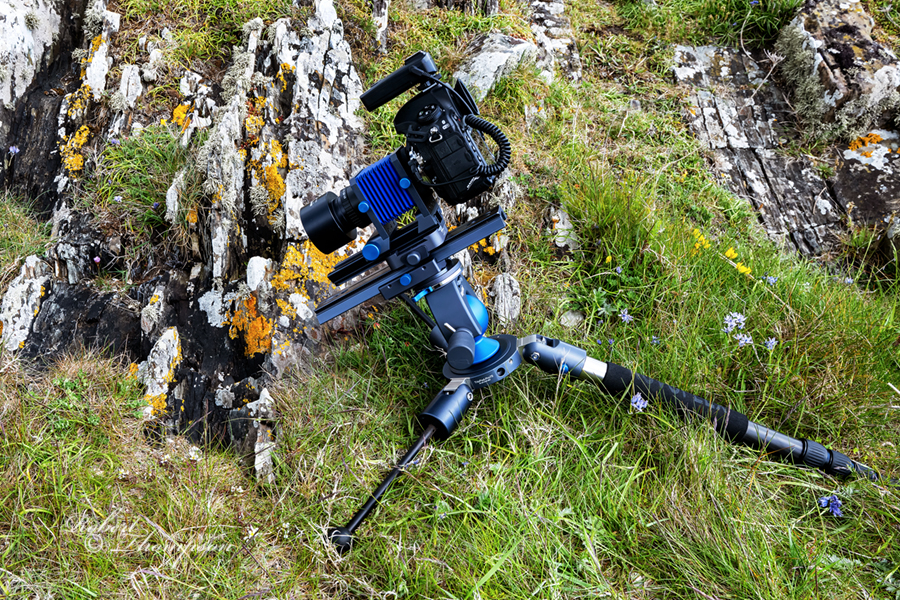
Novoflex Bellows-BAL-F & APO Digitar lens
The beauty of a modular tripod system is you can replace legs to suit the work you are doing. I used a single, short Triopod leg and two small mini legs to help me to get the tripod into the ideal position. The larger, longer legs would encroach on the rock making it difficult to position precisely.
When light is strong and directional, I attach a diffuser via a gooseneck, which I can clamp to the tripod leg. I can position it to soften the light and reduce the shadows. All macros are corrected for flatness of field and will deliver edge-to-edge sharpness, which makes them ideally suited to this type of photography. Virtually all current macros now have continuous focusing up to 1:1 (lifesize), which saves having to add and remove extension tubes in the field. However, if you don’t own a macro you can still take excellent close-ups of lichens using a short telephoto lens around 100 mm combined with extension tubes. The curvature in the glass in non-macros makes it difficult to retain sharpness right to the edge of the frame. You are better reducing the magnification of the image on screen to take this into consideration and then crop.
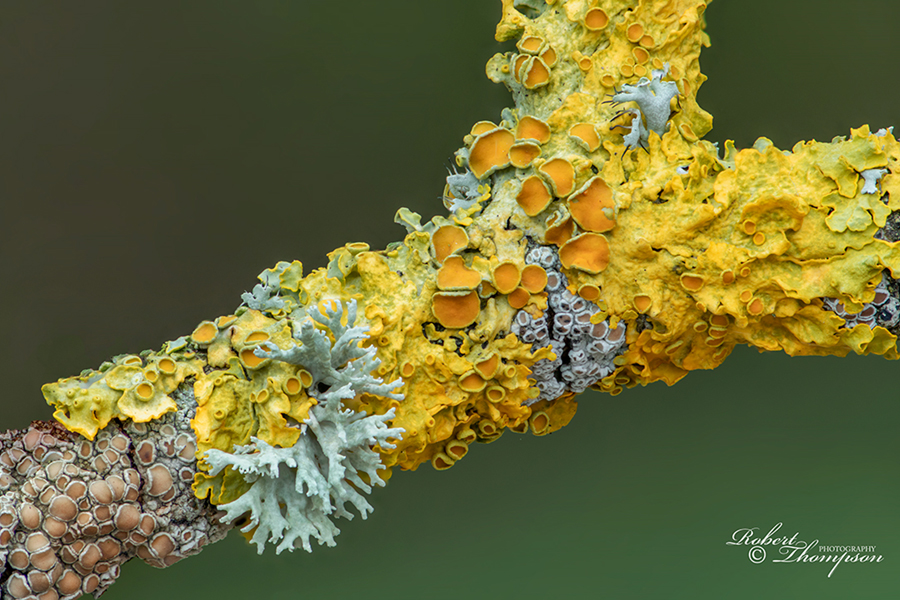
Xanthoria parietina, Lecanora chlarotera with a lichenicolous fungus, Evernia prunastri and Physcia sp.
It’s amazing how small branches can support many different species. This small twig had a lichen community that had colonised most of its length. It was necessary to focus stack the images to retain sufficient depth of field to keep all of them in focus. Photographed using Novoflex Castel-Micro and XQ Castel focusing rail.
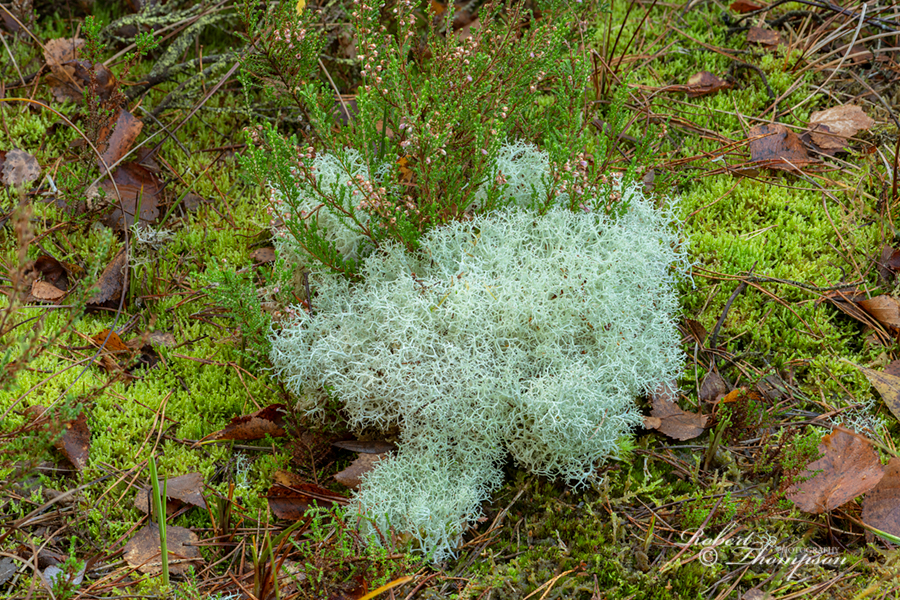
Reindeer Moss Cladonia portentosa
An attractive species found commonly on heathland, bogs and acid sand dunes. It is protected under the EU habitats directive and a priority species. It can be prolific in some habitats.
To be perfectly honest the majority of photographers do not set out specifically to photograph lichens, but encounter some of the richly coloured species by chance and can’t resist the opportunity to photograph them especially if there is little else about. Identification is the major problem for many photographers, and the lack of appropriate publications to assist with this process was a major drawback. However, times have changed, and there are many publications and websites now, which are devoted to the study of lichens and include photography to assist in the identification of many commonly encountered species. Unfortunately, only a small number of lichens have established common names. Lichen photography is something that you can carry out throughout the autumn and winter months. You can visit different habitats from coastal rocks to graveyards. All will produce some very colourful and diverse species.

